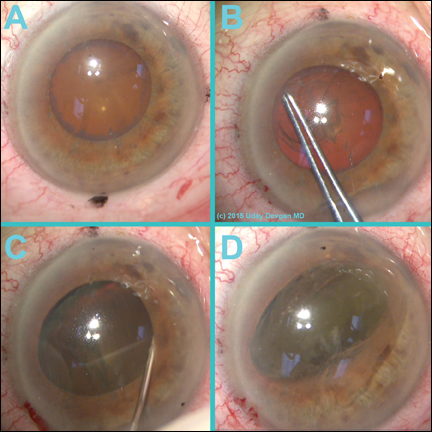Cataract surgery can be performed in pseudoexfoliation cases without expansion devices
Patients with pseudoexfoliation syndrome pose significant challenges during cataract surgery: The zonular apparatus is often weak with some degree of phacodonesis, and the pupil tends not to dilate well, limiting access to the cataract. These eyes are at a higher risk of both intraoperative and postoperative complications, which can result in compromises in visual recovery. The technique of cataract surgery in these eyes with small pupils has traditionally involved the use of mechanical pupil expanders such as iris hooks or rings, but there is an alternate method to achieve an excellent and safe outcome.
Preoperative consultation
Our patient comes in for consultation after failing the vision test for his driver’s license renewal. He presents with 2 to 3+ nuclear cataracts in both eyes, which are limiting his best corrected vision to 20/50 and even worse with glare testing. Preoperatively his maximum pupil dilation is 4 mm in diameter, and he is noted to have an axial length of 23 mm with an anterior chamber depth of 2.8 mm in each eye. Because the anterior chamber depth is reasonable and not shallow, we can surmise that the zonular apparatus is in reasonable shape without too much laxity. A pearl that I learned from Alan Crandall, MD, is to beware of a shallow anterior chamber in patients with pseudoexfoliation because it usually means that the entire lens-iris diaphragm is loose and pushing forward, thereby shallowing the anterior chamber.
Our patient desires a refractive outcome of plano in both eyes, although he is noted to have 2.5 D of regular corneal astigmatism in each eye. Our decision is clear: He should have cataract surgery with toric lens implants in each eye. The chosen lens was an Alcon AcrySof toric with aspheric optics and a blue-filtering tint. But because he only dilates to 4 mm, once we implant the lens, will we be able to see the toric markings, which are at the 5-mm zone on the optic?

Images: Devgan U

Intraoperative technique
For this case, we are going to use a technique of bringing the nucleus out of the capsular bag and tilting it into the iris plane so that the iris sphincter is holding it in place. This requires a capsulorrhexis of at least 5 mm in diameter, but our current pupil size is just 4 mm. Injecting viscoelastic at the pupil margin can help to push the iris and expand the pupil, a technique Robert Osher, MD, has called viscomydriasis. We can then make the capsulorrhexis right at the pupil margin or, even better, just underneath it. Most experienced surgeons, having done thousands of procedures already, can make the capsulorrhexis larger than the pupil without directly visualizing it.
Balanced salt solution is used to hydrodissect the nucleus out of the capsular bag and then tilt it into the iris plane. The iris sphincter will now hold the nucleus in place while the surgeon uses a phaco chop technique to emulsify and aspirate it. This technique brings the nucleus out of the capsular bag in order to minimize stress on the zonules. And even in cases in which there is zonular laxity, this supracapsular technique can be safer than intracapsular techniques such as divide-and-conquer.
Typically these types of maneuvers would result in progressive pupillary miosis during the surgery, giving us a smaller pupil at the end of nucleus removal. In this case, however, we are using Omidria (Omeros) in the infusion solution. Omidria is a preservative-free, bisulfite-free combination of phenylephrine 1% to aid in mydriasis and ketorolac 0.3% to prevent miosis and address postoperative pain. Using this solution, we are able to maintain the pupil and even expand it during surgery so that when we are ready for IOL implantation, the pupil is larger than when we began. In our case, the initial pupil size was 4 mm, which yields a pupillary area of 12.5 mm2, and then later in the case it was 5 mm in diameter, which is an area of 19.6 mm2, which is an increase in working area of more than 50%. This larger pupillary opening is critical because we need to visualize the toric markings on the lens optic, and these are at the 5-mm zone.
Postoperative results
Patients with pseudoexfoliation can have more postoperative pain and inflammation than patients with more routine cataract types. However, in this case, the benefit of the intraoperative infusion of Omidria, which contains ketorolac, helped this patient to have a pain-free postoperative recovery without complications and a great visual result with the toric lens.
- For more information:
- Uday Devgan, MD, is in private practice at Devgan Eye Surgery, Chief of Ophthalmology at Olive View UCLA Medical Center and Clinical Professor of Ophthalmology at the Jules Stein Eye Institute, UCLA School of Medicine. He can be reached at 11600 Wilshire Blvd. #200, Los Angeles, CA 90025; email: devgan@gmail.com; website: www.DevganEye.com.
Disclosure: Devgan reports he is a consultant to Alcon and Omeros. He reports no relevant financial disclosures regarding the products mentioned in this article.
